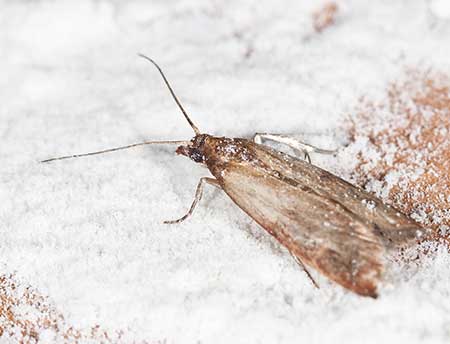Nothing makes me shudder more than the thought of indian meal moths in my food pantry. We all have our bug fears & rants. Mine happens to be this evil little time gobbler of an insect that invades our food. This particular blog is personal for me, today. If you have not heard or experienced indian meal moths before then you will want to definitely read on.
Where are all of these moths coming from???
This will be the first thing that you say. Indian meal moths seem to come from nowhere. In the beginning it’s one here or there. After a couple of days it’s three or four. The next thing you know… they’re everywhere!
They struck our family last summer when we were in the middle of a family emergency. We had to travel to and from Tennessee for weeks on end. It’s almost like they sensed that we had no time to find the exact source of the problem. If you can find the source of the problem quickly then you will avoid the pantry crisis. We did not have the time to look at every item in the pantry like we KNEW we should do. We opened a few items like cereal, corn starch, flour, dog food, and nuts. We found several infested foot items and considered the matter finished.
How long do indian meal moths live?
The larvae of indian meal moths can take anywhere from 2 to 14 days to hatch. An adult will live anywhere from 5 to 25 days. Of course, this is all depending on the environmental conditions. In my book, 5 minutes is too long.
The indian meal moths continued to flutter about my kitchen for days on end. The problem was becoming worse by the day. Until finally, I said enough is enough. I’m tearing apart the pantry!! Well, I found the nasty culprit. It was a lovely tin of popcorn from Christmas (thanks Mom!) that had gotten pushed to the corner over time and forgotten about. When I opened up that tin it was like something from that scene in the movie The Green Mile where John Coffey “takes back” the bugs. There were literally hundreds of them and they swarmed out of that tin in a black cloud all around my head. To say that I invented a new dance in the kitchen of my Murfreesboro, TN home that day would be an understatement.
Actually, finding the source was great news! I knew that I could finally get down to solving the problem. I removed every food item AND sealed container and inspected it. Every corner and crevice. Any containers with larvae, pupae, or moth was discarded in a trash bag. Everything else was wiped down thoroughly with a soapy sponge. Every time I saw a moth I would quickly suck it up in the vacuum.
There were all stages of indian meal moths everywhere I looked: In the food, crevices of bags, crevices of boxes, the screw-on lids of herbs, cracks of wall shelving, corners of pantry, inside lip of the chip clips. Everywhere! I even found larvae & pupae in “sealed” storage containers holding herbs and seasonings that I had blended together myself. Some things are just not as sealed as you think they are. I was very disappointed to have to throw away those blends. Herbs and seasonings can be so expensive!
The process was very time consuming, but in the end the problem was resolved. Did I mention that no pesticides were used? The solution for indian meal moths can never be accomplished with pesticides. Sometimes, the job of a professional is not in what they do but in what they know. In the work of an exterminator this is called Integrated Pest Management or IPM. Basically, it is a combination of common sense and scientific principles we use to solve a pest problem whereby we reduce the risk to the environment and people. In the case of indian meal moths, we cannot treat the food or their containers so we rely on IPM to remedy the problem.

